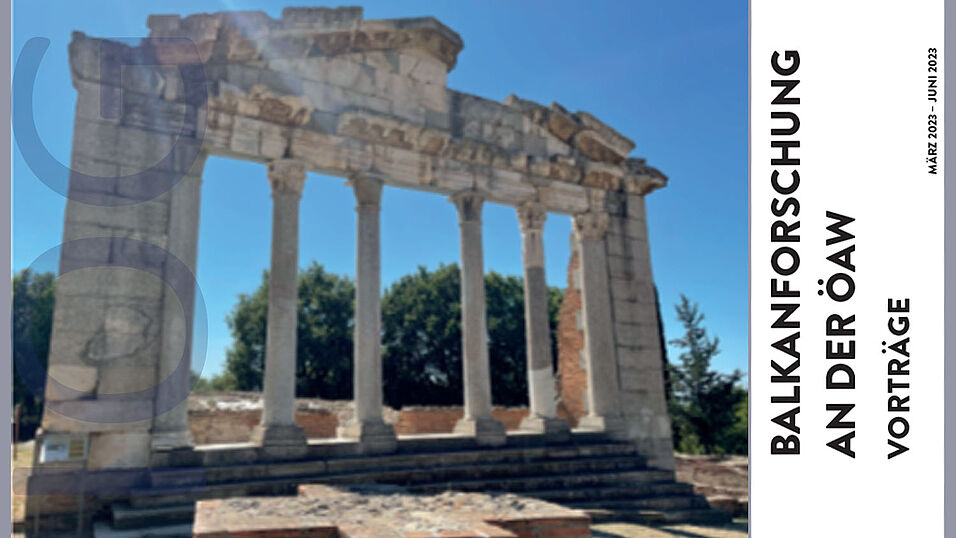Balkanforschung an der ÖAW
Österreich und der Balkanraum sind seit Jahrhunderten eng miteinander verflochten.
Als wichtiger kultureller, gesellschaftlicher und politischer Bezugsort für die Gesellschaften des Balkans war und ist Wien auch ein Zentrum der wissenschaftlichen Beschäftigung mit dieser Region. Der 2017 eingerichtete Forschungsbereich Balkanforschung am Institut für die Erforschung der Habsburgermonarchie und des Balkanraumes (IHB) greift diese Forschungstradition auf und versucht in seiner multidisziplinären Ausrichtung neue Akzente zu setzen.
Die Vorträge werden unter Beachtung der zum jeweiligen Zeitpunkt geltenden Sicherheitsvorschriften stattfinden und in jedem Fall auch im Internet via zoom mitverfolgt werden können.
https://www.oeaw.ac.at/ihb/forschungsbereiche/balkanforschung/veranstaltungen
Die Vorträge finden in diesem Semester in Kooperation mit dem Institut für Osteuropäische Geschichte statt und werden im Hörsaal des Instituts für Osteuropäische Geschichte UniCampus Hof 3 2R-EG-07 abgehalten.
KONTAKT:
Dr. Joachim Matzinger
joachim.matzinger@oeaw.ac.at
T: +43 1 51581-7363
PROGRAMM
Flyer
18.00-19.30 UHR
HÖRSAAL DES INSTITUTS FÜR OSTEUROPÄISCHE GESCHICHTE UNI-CAMPUS
HOF 3 2R-EG-07
SPITALGASSE 2 / HOF 3, EINGANG 3.2 (CAMPUS), 1090 WIEN
[AUSSER 5.-6. MAI, 10.-12. MAI; S. DORT]
DIENSTAG, 21. MÄRZ 2023
Stefan Rohdewald | Leipzig
Die Ukraine als Zentrum transosmanischer Mobilitätsdynamiken: Ukrainische Geschichte
im überregionalen Kontext
DIENSTAG, 28. MÄRZ 2023
Dana Caciur | Bukarest
Across the Balkans. Agents of a Private Correspondence between Venice and Wallachia
(Late 16th Century)
DIENSTAG, 25. APRIL 2023
Benjamin Arbel | Tel Aviv
The Ottoman Balkans as a Refuge for Jewish Expellees (Late 15th to early 16th Century):
Some Critical Remarks and Open Questions
FREITAG, 5. – SAMSTAG, 06. MAI 2023
ORT: PSK, RAUM 04 01 A B18 01 IM 4.OG
Ovidiu Olar (Organisator) | Wien
1st ORTHPOL WORKSHOP: Orthodoxy, Schism, Heresy in Early Modern Europe: The
Loukaris ‘Affair’
MITTWOCH, 10. – FREITAG, 12. MAI 2023
ORT: BESPRECHUNGSRAUM 3. STOCK PSK (RAUM 3A19)
Katsiaryna Ackermann (Organisatorin) | Wien
International Conference: Concepts In Sociocultural Space: The Balkans And The Caucasus In Focus
DIENSTAG, 23. MAI 2023
Andreas Lippert, Joachim Matzinger | Wien
Buchvorstellung: A. Lippert, J. Matzinger. "Die Illyrer. Geschichte, Archäologie und
Sprache"
DIENSTAG, 06. JUNI 2023
Damir Imamović | Sarajevo
Gendering Traditional Music: A Case of The Bosnian Sevdah

